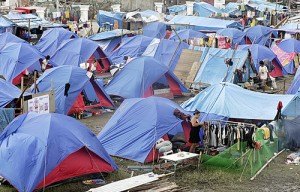The more than 2,500 survivors living in so-called tent cities in Tacloban City appear to be a clear proof of the slow response and failure of the national government to put them in houses five months after the onslaught of Super Typhoon Yolanda.
Tacloban City, capital of Leyte province in the Visayas region, was the hardest hit by the November 8, 2013 typhoon that killed thousands of people and destroyed billions in property in the region and a few other neighboring provinces and cities.
In an interview, Federico Anido, chairman of the City Disaster Risk Reduction and Management Council-Tacloban, said the national government is yet to hand over the national fund to the local government unit. The fund is needed to house more than 400 to 500 families or roughly 2,500 individuals who are still staying in the tent cities.
Bunkhouses provided by the Department of Public Works and Highways, he pointed out, were only good for 1,200 families, when 14,000 families were displaced by Yolanda in the whole city of Tacloban.
“The No. 1 reason [why the survivors are still here and living in tents] is the insufficient number of bunkhouses provided by the national government,” Anido said.
The economy in the city, he added, is down, noting that only 1,500 business establishments out of a total of 7,000 had reopened.
Tacloban City, classified as a highly urbanized city or HUC, is the business hub of Eastern Visayas.
The Department of Energy has restored power to only 60 percent of affected areas in the city, Anido said.
He added that the city government had identified a relocation site for permanent houses for the survivors but it will take some time to develop the site and build the houses.
The Department of Interior and Local Government (DILG), he said, recently released P200 million for reconstruction of public markets, schools and roads.
But the DILG said the money cannot be used “to reconstruct houses for Yolanda survivors.”
Anido appealed to the Department of Social Welfare and Development to provide sustainable livelihood or a cash-for-work program so that the Yolanda survivors would be able to earn income on their own.
The People Surge, an alliance of Yolanda survivors in Tacloban City, is set to organize massive demonstrations in various areas in the city and in nearby Samar province to air their grievances about the supposedly slow response of the government to the plight of the Yolanda survivors.
Samar was also hit hard by the super typhoon.


